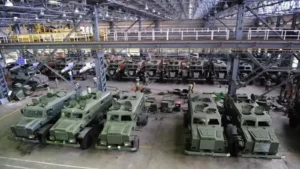GS 3 – Internal security

Context:
- India has progressively opened its defence manufacturing sector to private players since 2016-17 to reduce dependence on imports and boost domestic production.
- Private sector participation is part of the government’s Atmanirbhar Bharat & Make in India defence initiatives.
Data (FY 2024-25):
| Contributor | Defence Production (₹ crore) | Share (%) |
| Private Sector | 33,979 | 22.56% |
| DPSUs (Defence PSUs) | – | 57.50% |
| Ordnance Factories | – | 14.49% |
| Non-defence PSUs | – | 5.4% |
| Total Defence Production | 1,50,590 | 100% |
Trend:
-
- 2016-17: 19%
- 2022-23: 19.39%
- 2023-24: 20.93%
- 2024-25: 22.56% → highest private sector share since 2016-17.
Observation: While the private sector’s share is rising, the majority still comes from DPSUs, Ordnance Factories, and other PSUs.
Significance:
- Boost to Atmanirbhar Bharat: Encourages domestic manufacturing and reduces import dependence.
- Industrial Growth: Private participation drives technology innovation, skill development, and employment.
- Strategic Autonomy: Enhances India’s defence preparedness and indigenous capability.
- Economic Impact: Defence production grew from ₹46,429 crore (2014-15) to ₹1.50 lakh crore (2024-25).
- Budgetary Trends: Defence budget rose steadily from ₹2.53 lakh crore (2013-14) to ₹6.81 lakh crore (2025-26).
Initiatives Supporting Private Sector:
- Defence Procurement Policy (DPP) reforms
- Strategic Partnerships (SP) model for private firms in aerospace, naval, and land systems
- Incentives under Make in India – Defence to encourage technology transfer and joint ventures




